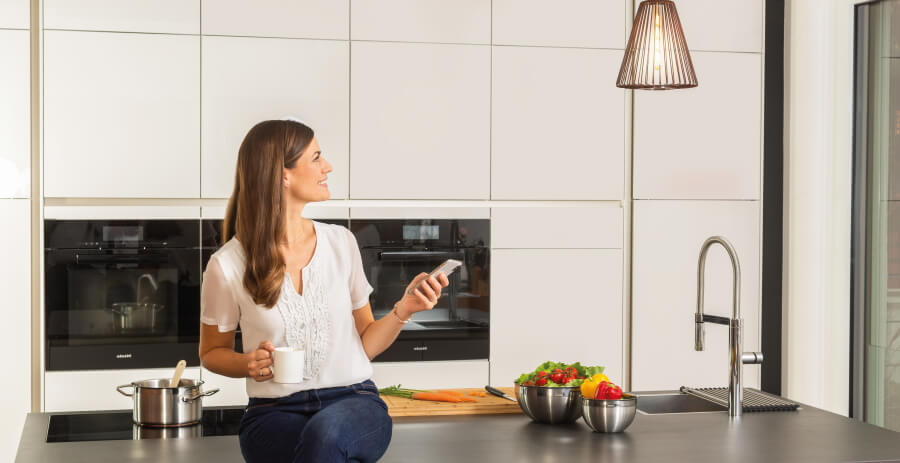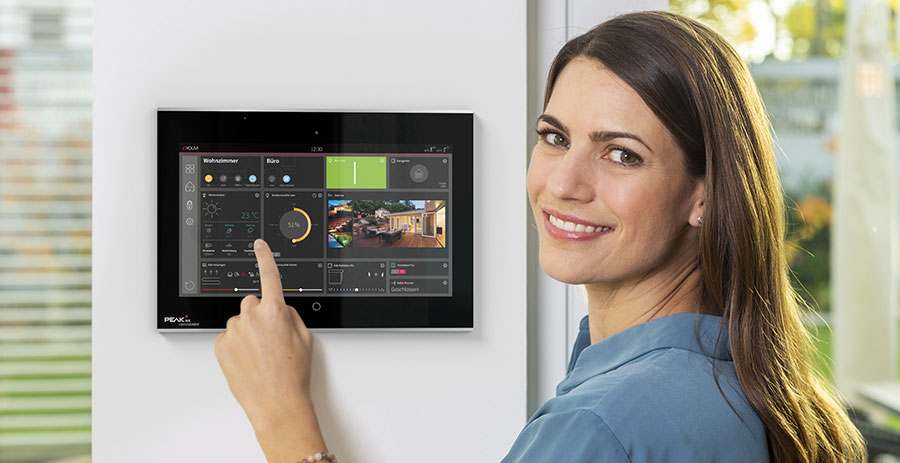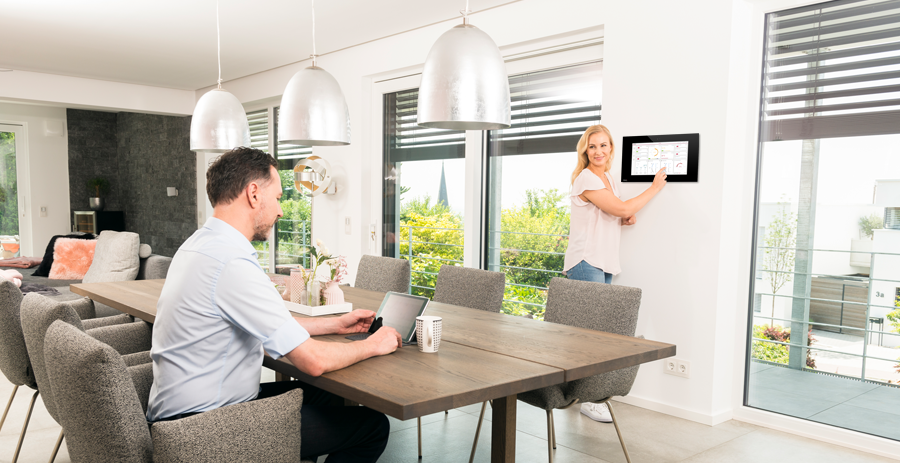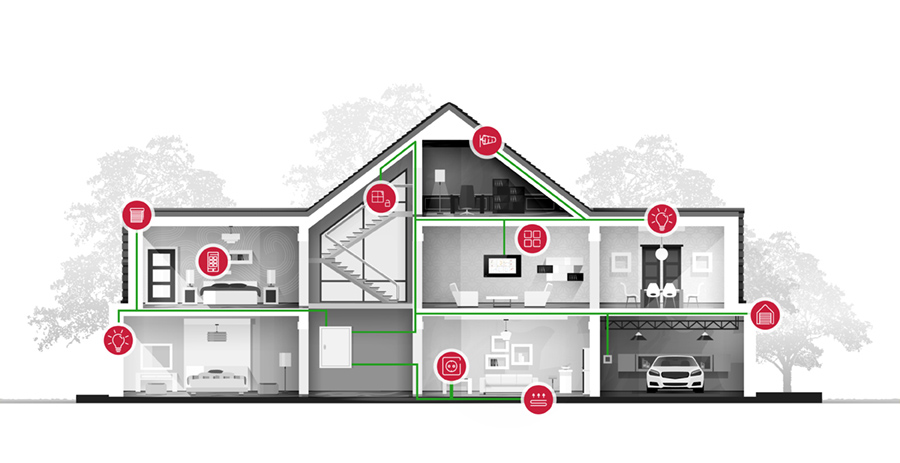The first question you need to ask yourself when planning a smart home is which functions you need and which smart home system you want to rely on.
For automatic control of heating, shutters and lights, it is necessary that the devices are connected to each other via a central control unit. Technically, the data exchange can be realized in different ways: Wirelessly or through intelligent cabling in the building.
This article shows the advantages and disadvantages of the wired KNX standard compared to wireless solutions such as Zigbee or EnOcean.
Index
New or existing building - Where should the smart home system be installed?
The most decisive question is in which property you want to install the Smart Home System.
The prerequisite for an intelligent KNX network is the installation of the green bus cable in the building. This is usually laid together with the power supply. Since the walls have to be opened to lay the cables in existing buildings, this variant is only suitable for new buildings or when extensive renovations are planned.
The exception: an empty pipe system has been installed in advance, through which the cables can be pulled afterwards.
Wireless systems, on the other hand, can also be easily installed in existing buildings or rental properties. Wireless components can usually be attached without any drilling: smart heating thermostats, for example, can be attached directly to the heaters, and smart light bulbs are mounted directly in the lamps.
As easily as they are installed, they can also be removed again and simply taken along, for example, when moving house.
Pros and cons of wireless solutions
Wireless standards for home automation must transmit data quickly, securely and with low energy consumption. WLAN requires a comparatively large amount of energy, so other wireless protocols such as ZigBee, Z-Wave or EnOcean have been developed as alternatives.
Manufacturers like Phillips Hue (smart lighting), Somfy (shutter control), Tado (heating thermostats) or Gosund (smart sockets) use these openly accessible radio protocols for their smart devices. They are usually controlled via the smartphone and the manufacturer's own app.
In addition to such open wireless protocols, there are also those developed by individual companies, such as Homematic IP.
Advantages of wireless solutions
You can usually set up such wireless solutions easily by yourself. There is no need for extensive changes in the building, as the components can be easily retrofitted. If required, you can add further devices or uninstall components again.
Wireless solutions are particularly suitable when only individual areas, such as lighting or the room climate, should become smart. There is a wide variety of manufacturers and products, so you can also find many cost-effective solutions.
Disadvantages of wireless solutions
The large number of different wireless solutions also means that they are only compatible with each other to a limited extent. In addition, you usually control the system via the manufacturer's own smartphone app. If you do not choose a provider that smartens various areas in the building, you will either have to install various control apps on your smartphone or set up a hub that unites all devices, for example Amazon Alexa or Apple Homekit.
One solution could be the planned wireless standard matter, which is the result of a joint initiative by Amazon, Apple, Comcast, Google, SmartThings and the former Zigbee Alliance. It is currently still in the development stage.
Depending on the transmission standard, the range of the radio signals also varies. Radio waves - whether WLAN, Bluetooth, ZigBee or EnOcean - are attenuated by walls and ceilings depending on the wavelength. Depending on the building environment and transmission power, the range for ZigBee is 10 to 20 meters, for EnOcean 30 meters. Under ideal conditions, further radio transmission is also possible. Nevertheless, you should take this into account during planning.
Data transmission can also be affected if the same radio frequency is used increasingly. ZigBee, for example, uses the frequency 2.4 GHz, like WLAN and Bluetooth, and the planned matter standard will also use this frequency.
Many wirelessly connected devices are powered by batteries if they are not directly supplied with electricity, as in the case of smart light bulbs, for example. The batteries have to be replaced regularly. If this is forgotten, the smart home is quickly gone.
Advantages and disadvantages of the wired KNX system
The most popular wired smart home system is KNX. KNX is a widely used standard supported by many manufacturers and has been on the market for over 30 years.
In addition to KNX, there are also manufacturers' own systems that network via cable, such as Loxone or Busch-free@home.
Advantages of KNX wiring
KNX offers a very large variety of available products from different manufacturers and also a high compatibility due to the worldwide standard. This means that there is no dependence on a single supplier. Should a single manufacturer go out of business, a replacement device from another manufacturer can still be found 20 years from now.
This wide range of products allows you to strongly customize and extensively automate your smart home system without being dependent on one manufacturer and its further development.
Compared to wireless solutions, the laid data cables guarantee smooth transmission and high reliability, as well as high range due to the laying of the cables throughout the house.
The KNX standard is also used a lot in industrial buildings, so the service life of the products is high. In addition, the standard has been established on the market for over 30 years and demonstrably increases the value of a property.
Disadvantages of KNX wiring
For a complete KNX system you need a detailed planning in advance, because the system can be installed only with structural measures. The subsequent installation of additional lines is usually associated with a rather high effort.
The installation of the lines and the setup of the system must be done by a system integrator or electrician. They can also advise you on the planning.
Also later adjustments or extensions of the system, usually need to be made by the supervising system integrator or electrician. Accordingly, the acquisition costs are significantly higher than for a self-installed wireless solution.
Radio or cable - Which offers more security?
Wired systems have the advantage that hackers can only hack into the system if they can get to the cables. That's why outdoor devices should be specially secured. The KNX Association gives advice on how to install a KNX system securely in their guide: https://www.knx.org/knx-en/for-professionals/benefits/knx-secure/. In addition, with KNX Secure you can also rely on an encrypted transmission of the data, if the integrated devices support this.
Wireless systems rely mostly on encryption, as the data would otherwise be very easy to read as soon as you are within range (near the house). Due to this encryption, radio-based systems are similarly safe from reading data as cable-based systems, but can be prevented from transmitting data by jammers.
It is advisable to consult an expert when setting up both systems. Especially if the control is done via smartphone, it is important to protect your WLAN effectively and to use secure passwords for remote access via the Internet.
Conclusion: Expand wired KNX system with wireless solutions
A wired KNX system offers many advantages, especially in new buildings, that wireless solutions can only compete with to a limited extent.
The supposed disadvantage that cables offer little flexibility can be offset by a sensible empty conduit planning. Furthermore, it is possible to complement a KNX system with radio solutions. KNX itself offers the KNX RF standard for this purpose as an option for expansion.
In rental apartments, radio solutions are definitely a good way to make your apartment a bit smarter. Whether you want to take on the effort of laying cables in existing buildings is an individual decision.









